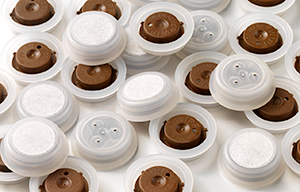Degassing valves

Coffee manufacturers strive to create a product that has a great taste and unique aroma. Therefore, every major manufacturer of high-quality coffee is well aware that gases are emitted during the roasting process, 80% of which are CO2. Gases also continue to be released even after packaging roasted coffee in a package. Proper packaging preserves the freshness, integrity and shelf life of ground or whole bean coffee.
 Benefits of using degassing valves:
Benefits of using degassing valves:
— Degassing valves allow gases to escape from the bag, thereby providing greater flexibility of the package during storage and movement and maintaining its appearance.
— Prevention of oxidation. While oxygen allows us to breathe and live, it is also a destructive factor for coffee. What does oxidation mean for coffee? This is the main factor due to which the product becomes tasteless and loses its shelf life.
— Performance. It has already been mentioned that CO2 is emitted from coffee immediately after roasting. In particular, for ground coffee, a third of CO2 is released immediately, and another third of the gas is released over the next 40 minutes. Without the use of a degassing valve, the transition from firing to packaging would take longer.
— Initially, the internal degassing valves were designed to protect coffee from external influences, but over the past few years their manufacturing technology has been improved and selected for other products, such as dough, sauerkraut, soy products, etc.
Let’s give an applause to these tiny valves for the work they do to make our coffee delicious. As we can see, this simple mechanism does not allow the accumulated gas to accumulate in the package while preventing oxygen from entering the bag, which not only provides freshness and better quality, but also increases the efficiency of the packaging process in production.

